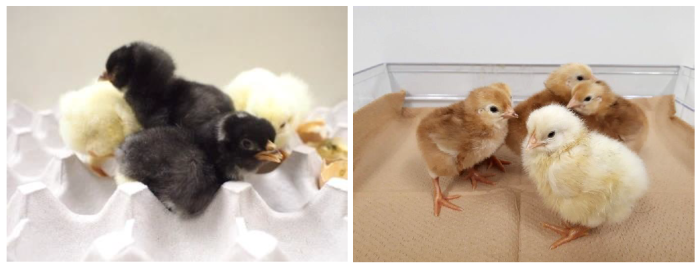Scientists from Hiroshima University produced OVM knocked out chickens using genome editing tools. Colored chickens are knockout chickens. (Ezaki et al. 2023, Food and Chemical Toxicology)
Researchers have developed a chicken egg that may be safe for people with egg white allergies. Chicken egg allergies are one of the most common allergies in children. Though most children outgrow this allergy by age 16, some will still have an egg allergy into adulthood. Egg white allergies can cause a variety of symptoms, including vomiting, stomach cramps, breathing problems, hives, and swelling and some people with egg white allergies are unable to receive certain flu vaccines.
Using genome editing technology, researchers have produced an egg without the protein that causes egg white allergies. This protein, called ovomucoid, accounts for approximately 11% of all the protein in egg whites.
Research detailing the food safety profile of this modified egg, called the OVM-knockout, was detailed in a paper published in Food and Chemical Toxicology in April 2023.
“To use OVM-knockout chicken eggs as food, it is important to evaluate its safety as food. In this study, we examined the presence or absence of mutant protein expression, vector sequence insertion, and off-target effects in chickens knocked out with OVM by platinum transcription activator-like effector nucleases (TALENs),” said Ryo Ezaki, an assistant professor at the Graduate School of Integrated Sciences for Life at Hiroshima University in Hiroshima, Japan. TALENs are restriction enzymes that recognize specific DNA sequences and break or cut them.
In order to develop the OVM-knockout eggs, researchers needed to detect and eliminate the ovomucoid protein in the egg whites. TALENs were engineered to target a piece of RNA called exon 1, which codes for specific proteins. The eggs produced from this technique were then tested to ensure there was no ovomucoid protein, mutant ovomucoid protein, or other off-target effects. The eggs had the desired frameshift mutation, which is a mutation created by inserting or deleting nucleotide bases in a gene, and none of them expressed mature ovomucoid proteins. Anti-ovomucoid and anti-mutant ovomucoid antibodies were used to detect any traces of the protein, but there was no evidence of ovomucoid in the eggs. This means that mutant ovomucoids could not create new allergens. This is an important step in determining the safety profile of the eggs.
Other gene editing tools, such as CRISPR, tend to have off-target mutagenesis effects. This means that new mutations are prompted by the gene editing process. However, whole genome sequencing of the altered egg whites showed mutations, which were possibly off-target effects, were not localized to the protein-coding regions.
“The eggs laid by homozygous OVM-knockout hens showed no evident abnormalities. The albumen contained neither the mature OVM nor the OVM-truncated variant,” said Ezaki. “The potential TALEN-induced off-target effects in OVM-knockout chickens were localized in the intergenic and intron regions. Plasmid vectors used for genome editing were only transiently present and did not integrate into the genome of edited chickens. These results indicate the importance of safety evaluations and reveal that the eggs laid by this OVM knockout chicken solve the allergy problem in food and vaccines.”
Looking ahead, researchers will continue to verify the safety profile of the OVM-knockout eggs. Because some people are highly allergic to this specific protein, even small amounts of ovomucoid can cause a reaction. Researchers will need to perform additional immunological and clinical studies to determine the safety of the OVM-knockout eggs. At this time, researchers have determined that OVM-knockout eggs are less allergenic than standard eggs and can be safely used in heat-processed foods that patients with egg allergies can eat. “The next phase of research will be to evaluate the physical properties and processing suitability of OVM-knockout eggs, and to confirm their efficacy through clinical trials,” said Ezaki. “We will continue to conduct further research toward the practical application of allergy-reduced eggs.”
Other contributors include Tetsushi Sakuma, Mei Matsuzaki, Takashi Yamamoto, and Hiroyuki Horiuchi of the Graduate School of Integrated Sciences for Life at Hiroshima University and Daisuke Kodama, Ryou Sasahara, and Taichi Shiraogawa from the R&D Division of the Institute of Technology Solution at Kewpie Corporation in Tokyo Japan.
The Japan Society for the Promotion of Science KAKENHI (19H03107, 19K22286) and JST COI Grant Number JPMJPF 2010 supported this research.
Journal: Food and Chemical Toxicology
Title: Transcription activator-like effector nuclease-mediated deletion safely eliminates the major egg allergen ovomucoid in chickens
Authors: Ryo Ezaki, Tetsushi Sakuma, Daisuke Kodama, Ryou Sasahara, Taichi Shiraogawa, Kennosuke Ichikawa, Mei Matsuzaki, Akihiro Handa, Takashi Yamamoto & Hiroyuki Horiuchi
DOI: 10.1016/j.fct.2023.113703

 Home
Home















